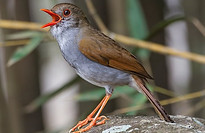



Ines G. Moran
Wildlife Bioacoustics Analytics
Syntax in bats
St Andrews (2022-current)
In collaboration with a fantastic team of researchers at the University of St Andrews, this project explores the vocal syntax of bats.
Vocal behaviour and impact of anthropogenic noise on the behaviour of Albatrosses
Midway Island (2022- current)
This project explores the soundscapes of several species of Albatrosses on Midway Island.


Vocal learning abilities in presumed vocal non-learners
New Zealand (2018- 2022)
Field site: Boundary Stream Mainland Island
Phylogenetic comparison in bioacoustics - phyloacoustics

Vocal learning is a behavior that influences the vocal outputs and the acoustic features of animals' vocalizations. Whether the evolution of vocal learning impacts the acoustic features of non-learned sounds, such as laughter or distress calls has never been tested. The goal of this project was to understand if and how the evolution of vocal learning impacts the evolution of innate calls. Phylogenetic and bioacoustic tools were used to compare the acoustic features of birds' distress calls acoustic features between vocal and non-vocal learning bird groups.

Vocal behaviour and vocal learning abilities of one of the most basal Passerine birds

Photo credit: Ines Moran. 2018
This project investigated the dialects, acoustic networks, genetic relatedness and vocal learning abilities of a cooperative breeding species native from New Zealand, the Titipounamu in maori or the Rifleman (Acanthisita chloris) in English. The Titipounamu is of particular interest to scientists in the field of animal vocal communication because it shares a common ancestor with parrots and oscine birds — two groups of birds known to learn their vocalizations.
Photo credit: Ines Moran. 2018
Genetics of animal communication

Vocal learners can often imitate sounds from genetically unrelated individuals. If genetically distant but socially close animals sound similar to one another, this may indicate that vocal imitation and possibly vocal learning are present in these animals. The goal of this project was to investigate the relationships between genetic, acoustic, geographic, and social similarities to determine how social proximity influences Titipounamu call features, a species assumed to lack vocal learning abilities. The results of this work showed that socially close individuals shared higher acoustic similarity among unrelated individuals.

Machine learning and detection of animal vocal signatures

Many animals have unique vocal signatures or "voice prints" that help recognize individuals or groups. Titipounamu produce very short and high pitch calls before feeding their chicks in their nests. Whether Titipounamu have unique individual and group vocal signatures was unknown, so we used machine learning techniques and spectrogram cross-correlation methods to find out. It turns out that both are present in titipounamu.

Conservation & Bioacoustics Projects - Marbled Murrelets and Spotted Owls
British Columbia Conservation Foundation, British Columbia, Canada (2017-2018)
Field sites: Various locations in British Columbia

Marbled Murrelets (Brachyramphus marmoratus) are threatened seabird species that nest in temperate rain forests. To determine their occupancy range in British Columbia, Canadian scientists from the Ministry of Forest, Lands and Natural Resource Operations collect audio recordings using Automated Recording Units (ARUs). Part of this project was to analyze audio recordings to localize Marbled Murrelets.
Photo credit: Rick & Nora Bowers

Marbled Murrelet Keheer. Kaleidoscope 2018

Photo credit: Sarah Chalmers & Ines Moran. 2018
The old growth forest of British Columbia - the preferred habitat of Spotted Owls (Strix occidentalis) - has drastically changed in the past century with active logging activities that favored the invasion of Barred Owls from the East Coast of North America. The population of Spotted Owls in British Columbia is threatened and scientists monitor their population using methods like Automated Recording Units (ARUs). Part of this project was to analyze audio recordings to localize Spotted Owls.

Spotted Owl hoot. Kaleidoscope 2018
Savannah Sparrows
Mennill Lab, University of Windsor, Canada (2015-2017)
Field site: Bowdoin Scientific Station, Kent Island, New Brunswick
This research investigated the aggressive escalation interactions and seasonal vocal variation of Savannah Sparrows communication (Passerculus sandwichensis). This project focused on models of signal escalation using a relatively unstudied signal and low-amplitude songs also known as soft songs. Ines Moran was also involved in a research experiment led by Dr. Mennill that aimed to elucidate the mechanisms of social song learning in Savannah Sparrows.

Photo credit: Dan Mennill. 2015
Song matching
Jankowski Lab, University of British Columbia, Canada (2014)
Song matching is a common communication strategy that birds use to interact with their conspecific neighbours. The goal of this project at the Jankowski Lab at the University of British Columbia, Canada, was to determine whether Orange-billed Nightingale thrushes (Catharus aurantiirostris) from Costa Rica were able of instantaneous song matching.

Photo credit: Jorge Obando

Artist: Helmi Hess. 2015
Photo Credit: Shantakumar. 2017

Vocal behaviours in mixed-species flocks
Queen University Biological Station, Ontario, Canada (Spring 2017)
Photo credit: Rolf Nussbaumer
Black-capped Chickadees (Poecile atricapillus) form mixed-species flocks with birds like woodpeckers in winter to increase their vigilance against predators. The goal of this project was to conduct playback experiments in Northern Ontario in Canada to test whether Black-capped Chickadees respond to heterospecific mobbing calls of Downy Woodpeckers, Picoides pubescens in winter.

Photo Credit: Ines Moran. 2017

